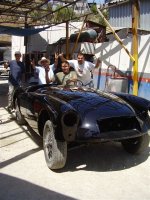Rick60
Senior Member
Offline
Some time ago I found out that the vacuum tube between carbs (HD8) and distributor on my engine was 'leaking' severely. So I guess I had no ignition advance due to vacuum.
Ok, fixed that the other day and had a closer look to the vacuum takeoff at the front carb. Noticed for the first time that the takeoff was 'upstream' the throttle disc.
Now my question is, how can there be vacuum or negative pressure? Engine draws air through the carbs into the cylinders. The amount of air the engine can breathe in is conditioned by the throttle disc amongst others. I always thought that the vacuum created between throttle disc and combustion chamber was used to advance the ignition, but that would mean the takeoff has to be 'downstream' the throttle disc.
Am I missing something or can anybody please enlighten me how this works?
Regards
Ok, fixed that the other day and had a closer look to the vacuum takeoff at the front carb. Noticed for the first time that the takeoff was 'upstream' the throttle disc.
Now my question is, how can there be vacuum or negative pressure? Engine draws air through the carbs into the cylinders. The amount of air the engine can breathe in is conditioned by the throttle disc amongst others. I always thought that the vacuum created between throttle disc and combustion chamber was used to advance the ignition, but that would mean the takeoff has to be 'downstream' the throttle disc.
Am I missing something or can anybody please enlighten me how this works?
Regards

 Hi Guest!
Hi Guest!

 smilie in place of the real @
smilie in place of the real @
 Pretty Please - add it to our Events forum(s) and add to the calendar! >>
Pretty Please - add it to our Events forum(s) and add to the calendar! >> 

